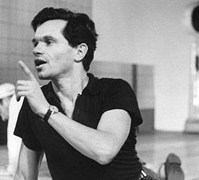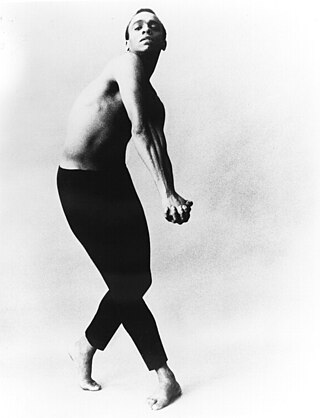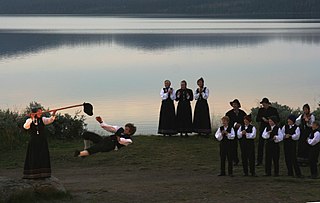Related Research Articles

Ballet is a type of performance dance that originated during the Italian Renaissance in the fifteenth century and later developed into a concert dance form in France and Russia. It has since become a widespread and highly technical form of dance with its own vocabulary. Ballet has been influential globally and has defined the foundational techniques which are used in many other dance genres and cultures. Various schools around the world have incorporated their own cultures. As a result, ballet has evolved in distinct ways.

Choreography is the art or practice of designing sequences of movements of physical bodies in which motion or form or both are specified. Choreography may also refer to the design itself. A choreographer is one who creates choreographies by practising the art of choreography, a process known as choreographing. It most commonly refers to dance choreography.

Contemporary dance is a genre of dance performance that developed during the mid-twentieth century and has since grown to become one of the dominant genres for formally trained dancers throughout the world, with particularly strong popularity in the U.S. and Europe. Although originally informed by and borrowing from classical, modern, and jazz styles, it has come to incorporate elements from many styles of dance. Due to its technical similarities, it is often perceived to be closely related to modern dance, ballet, and other classical concert dance styles.

Michael Kidd was an American film and stage choreographer, dancer and actor, whose career spanned five decades, and staged some of the leading Broadway and film musicals of the 1940s and 1950s. Kidd, strongly influenced by Charlie Chaplin and Léonide Massine, was an innovator in what came to be known as the "integrated musical", in which dance movements are integral to the plot.

Katherine Mary Dunham was an American dancer, choreographer, anthropologist, and social activist. Dunham had one of the most successful dance careers of the 20th century, and directed her own dance company for many years. She has been called the "matriarch and queen mother of black dance."
Peter Gennaro was an American dancer and choreographer.

Geoffrey Lamont Holder was a Trinidadian-American actor, dancer, musician, and artist. He was a principal dancer for the Metropolitan Opera Ballet before his film career began in 1957 with an appearance in Carib Gold. In 1973, he played the villainous Baron Samedi in the Bond film Live and Let Die. He also carried out advertising work as the pitchman for 7 Up.

Donald McKayle was an American modern dancer, choreographer, teacher, director and writer best known for creating socially conscious concert works during the 1950s and '60s that focus on expressing the human condition and, more specifically, the black experience in America. He was "among the first black men to break the racial barrier by means of modern dance." His work for the concert stage, especially Games (1951) and Rainbow Round My Shoulder (1959), has been the recipient of widespread acclaim and critical attention. In addition, McKayle was the first black man to both direct and choreograph major Broadway musicals, including the Tony Award-winners Raisin (1973) and Sophisticated Ladies (1981), and he worked extensively in television and film. As a young man he appeared with some of the twentieth century's most important choreographers, including Martha Graham, Anna Sokolow, and Merce Cunningham, and in some of Broadway's landmark productions, including House of Flowers (1958) and West Side Story (1957), where he served for a time as the production's dance captain. A Tony Award and Emmy Award nominee, McKayle held an endowed chair for the last decades of his life in the Dance Department at UC Irvine, where he was the Claire Trevor Professor of Dance. He previously served on the faculties of Connecticut College, Sarah Lawrence College, and Bennington College.
Gawain Garth Fagan, CD is a Jamaican modern dance choreographer. He is the founder and artistic director of Garth Fagan Dance, a modern dance company based in Rochester, New York.

Contemporary ballet is a genre of dance that incorporates elements of classical ballet and modern dance. It employs classical ballet technique and in many cases classical pointe technique as well, but allows a greater range of movement of the upper body and is not constrained to the rigorously defined body lines and forms found in traditional, classical ballet. Many of its attributes come from the ideas and innovations of 20th-century modern dance, including floor work and turn-in of the legs. The style also contains many movements emphasizing the body's flexibility.
The Prince Claus Fund was established in 1996, named in honor of Prince Claus of the Netherlands. It receives an annual subsidy from the Dutch Ministry of Foreign Affairs.

The Batsheva Dance Company is a renowned dance company based in Tel Aviv, Israel. It was founded by Martha Graham and Baroness Batsheva de Rothschild in 1964.
Talley Beatty was born in Cedar Grove, Louisiana, a section of Shreveport, but grew up in Chicago, Illinois. He is considered one of the greatest of African American choreographers, and also bears the titles dancer, doctor, and dance company director. After studying under Katherine Dunham and Martha Graham, Beatty went on do solo work and choreograph his own works which center on the social issues, experiences, and everyday life of African Americans. Beatty and his technique and style of dancing were both praised and criticized by critics and dancers of his day.

Modern dance is a broad genre of western concert or theatrical dance which included dance styles such as ballet, folk, ethnic, religious, and social dancing; and primarily arose out of Europe and the United States in the late 19th and early 20th centuries. It was considered to have been developed as a rejection of, or rebellion against, classical ballet, and also a way to express social concerns like socioeconomic and cultural factors.

Hallgrim Hansegård is a Norwegian choreographer and dancer whose background is rooted in his traditional halling dance training and contemporary dance. He is also known for leading a trio of dancers who danced alongside Alexander Rybak onstage at The Eurovision Song Contest 2009 which his country won.
Larry Keigwin an American choreographer and the artistic director of KEIGWIN + COMPANY.
Ivaldo Bertazzo is a Brazilian dancer, choreographer and movement therapist.

Frisner Augustin was a major performer and composer of Haitian Vodou drumming, and the first and only citizen of Haiti to win a National Heritage Fellowship from the National Endowment for the Arts in the United States, where he resided for forty years.
Carlton Harold "Jackie" Guy MBE is a Jamaican dancer, choreographer and teacher who has been based in the United Kingdom since the mid-1980s.
Lenora Antoinette Stines, better known as L'Antoinette Ọṣun Awade Wemo Stines is a Jamaican director, choreographer, author, actor and dancer. She is the founder and artistic director of L'Acadco: A United Caribbean Dance Force, an industry-leading contemporary dance company based in Jamaica. Stines is also the creator of the first Anglo Caribbean Modern Contemporary training procedure called L'Antech. L'Antech is an eclectic Caribbean contemporary technique that synthesizes African influences, Caribbean folklore, and is dominated by Jamaican Afro-Caribbean forms.
References
- ↑ Ayikodans, Jeanguy Saintus — the man behind the mission
- 1 2 Prince Claus Fund (2008) biography [ permanent dead link ]
- ↑ The Power of Culture, Prince Claus laureate Jeanguy Saintus: 'The dead provide strength and comfort' Archived 2016-03-04 at the Wayback Machine